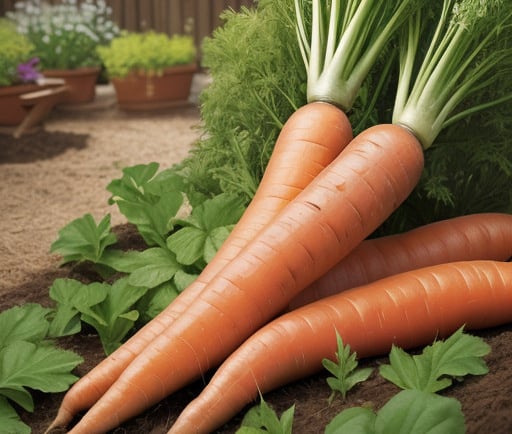Endless Carrots: Your Home Garden Guide
VEGETABLES


Introduction to Growing Carrots
Growing carrots in your home garden can be a highly rewarding experience, offering both enjoyment and numerous health benefits. As one of the most popular root vegetables, carrots are celebrated for their rich vitamin content, particularly Vitamin A, which is essential for good vision, immune function, and skin health. Beyond Vitamin A, carrots also provide vitamins K and C, as well as essential minerals like potassium and dietary fiber, making them a nutritious addition to any meal.
Not only are carrots packed with health benefits, but they are also remarkably versatile in the kitchen. Whether you prefer them raw in salads, cooked in soups, or even juiced, carrots can be incorporated into a wide range of dishes to enhance both flavor and nutritional value. Their natural sweetness and vibrant color make them a favorite among both adults and children, adding a delightful touch to any culinary creation.
Home gardening, particularly growing carrots, offers a sense of satisfaction and sustainability that is hard to match. Cultivating your own produce reduces reliance on store-bought vegetables, which often come with a carbon footprint due to transportation and packaging. By growing carrots at home, you can contribute to a more sustainable lifestyle while enjoying the freshest produce possible. Moreover, the process of gardening itself can be therapeutic, providing a sense of accomplishment as you nurture your plants from seeds to harvest.
In addition to the personal satisfaction and environmental benefits, home gardening can also foster a deeper connection with nature. Watching your carrots grow and thrive can instill a greater appreciation for the natural world and the food that nourishes us. Whether you are an experienced gardener or a novice looking to try your hand at growing vegetables, carrots are an excellent choice for a rewarding and sustainable gardening experience.
Preparing Your Garden for Carrot Planting
To begin your journey of growing endless carrots, selecting the right location is crucial. Carrots thrive in areas that receive full sunlight, ideally 6 to 8 hours per day. Ensuring your garden spot aligns with this requirement will foster optimal growth and yield.
Soil preparation is another key component. Carrots prefer loose, well-drained soil with ample organic matter. Start by tilling the soil to a depth of at least 12 inches to break up any compacted layers. Removing stones and debris is essential to prevent the roots from becoming deformed. Enrich the soil with compost or well-rotted manure to enhance nutrient content and improve soil structure.
Understanding soil pH levels is equally important. Carrots grow best in slightly acidic to neutral soil, with an ideal pH range of 6.0 to 6.8. Conduct a soil test to determine the pH level and amend it as needed. Lime can be added to raise the pH, while sulfur can help lower it.
For those with limited gardening space, raised beds or container gardening offer viable alternatives. Raised beds provide excellent drainage and allow for better control over soil quality. Ensure that the beds are at least 12 inches deep to accommodate the carrot's long roots. Similarly, containers should be deep enough, with adequate drainage holes to prevent waterlogging.
By meticulously preparing your garden, you set the stage for a bountiful carrot harvest. Each step—from selecting the right location, preparing the soil, understanding pH levels, to utilizing raised beds or containers—plays a vital role in ensuring your carrots grow healthy and strong.
Choosing the Right Carrot Varieties
When planning your home garden, choosing the right carrot varieties is crucial for a successful harvest. Carrot types, such as Nantes, Danvers, and Chantenay, differ significantly in their growth habits, flavor profiles, and preferred growing conditions. Understanding these differences will help you select the best carrots for your garden's unique environment.
Nantes carrots are a popular choice among gardeners due to their cylindrical shape, smooth texture, and sweet flavor. They thrive in loose, sandy soils and are known for their consistent growth and ease of harvesting. Nantes varieties are versatile and can be used in a wide range of culinary applications, from fresh eating to cooking and juicing.
Danvers carrots are characterized by their thick, tapered roots and deep orange color. They are well-suited for heavier soils, such as clay, due to their robust growth habit. Danvers carrots have a slightly earthy flavor, making them ideal for roasting and stews. Their hardy nature also makes them a good option for gardeners in cooler climates.
Chantenay carrots are short and stout with a broad shoulder and a conical shape. These carrots are particularly well-suited for shallow or rocky soils where longer varieties might struggle. Chantenay carrots have a sweet and tender texture, making them perfect for snacking and adding to salads. Their compact size also allows for dense planting, maximizing garden space.
When selecting carrot varieties for your garden, consider your local climate and soil conditions. For example, if you live in an area with heavy clay soil, Danvers carrots may be your best bet. Conversely, if your garden has loose, sandy soil, Nantes carrots will likely thrive. Additionally, think about the intended use of your carrots. If you plan to use them primarily for fresh eating, sweet varieties like Nantes or Chantenay are ideal. For cooking and preserving, the robust Danvers carrots are a great choice.
By carefully selecting the right carrot varieties for your garden, you can ensure a bountiful and delicious harvest. Pay attention to the specific needs and characteristics of each type, and tailor your choices to your garden's unique conditions for the best results.
Planting and Caring for Your Carrots
Planting carrots successfully begins with selecting the ideal time of year. Carrots thrive when planted in early spring or late summer to avoid extreme heat, which can negatively impact their growth. Sowing carrot seeds directly into the garden soil is recommended, as they do not transplant well. Ensure the soil is loose, well-drained, and free from stones to allow the roots to grow straight and unimpeded.
The seeds should be sown at a depth of approximately half an inch (1.25 cm) and spaced about 1 to 2 inches (2.5 to 5 cm) apart. Row spacing should be around 12 to 18 inches (30 to 45 cm) to provide ample room for growth and maintenance. As the seedlings emerge, it is crucial to thin them to maintain 2 to 3 inches (5 to 7.5 cm) between each plant, preventing overcrowding and promoting healthy root development.
Watering is a critical aspect of carrot care. Carrots require consistent moisture, especially during the germination period, which can take up to three weeks. A gentle, deep watering approach is best, ensuring the soil remains evenly moist but not waterlogged. Mulching around the base of the plants can help retain moisture, regulate temperature, and reduce weed growth.
Carrots are susceptible to various pests and diseases. Common pests include the carrot rust fly and aphids, which can be managed through organic methods such as introducing beneficial insects or utilizing row covers. For disease prevention, practice crop rotation and avoid planting carrots in the same location each year. Fungal diseases like leaf blight can be mitigated by ensuring adequate air circulation and avoiding overhead watering.
By adhering to these guidelines, you can cultivate a thriving carrot crop, ensuring a bountiful harvest of this nutrient-rich vegetable. Consistent care and attention to detail will yield the best results, allowing you to enjoy the fruits of your labor in your home garden.
Harvesting and Storing Carrots
Determining the right time to harvest carrots is crucial for ensuring optimal flavor and texture. Carrots are generally ready for harvest between 60 to 80 days after planting, depending on the variety. One of the primary indicators of maturity is the diameter of the carrot top. When the top reaches about 1/2 to 1 inch in diameter, it is usually a good sign that the carrot is ready to be pulled. Additionally, the color of the carrot is a strong indicator; a rich, vibrant hue typically signals that it is time to harvest.
For the best results, choose a cool, dry day for harvesting. Begin by loosening the soil around the carrots with a garden fork to avoid damaging the roots. Gently pull the carrots from the soil, ensuring that you do not break the tops or the delicate root tips. If the soil is particularly hard, consider watering the area a day before harvesting to soften it up.
Once harvested, it is essential to handle the carrots with care to maintain their quality. Start by removing the green tops, as they can draw moisture away from the roots. Gently rinse the carrots to remove any residual soil. It is advisable to avoid scrubbing too hard, as this can damage the skin and reduce their shelf life.
When it comes to storing carrots, keeping them fresh is key. Place the carrots in a perforated plastic bag and store them in the refrigerator. They can last for several weeks this way. For long-term preservation, consider freezing or pickling. To freeze, blanch the carrots in boiling water for a few minutes, then plunge them into an ice bath before drying and storing them in airtight containers. Pickling is another excellent option, which not only extends the shelf life but also adds a unique flavor profile to the carrots.
Creative Uses for Your Homegrown Carrots
Growing your own carrots offers a multitude of culinary opportunities that go beyond the basics. Homegrown carrots not only enhance the flavor of traditional dishes but also provide a nutritional boost to your daily diet. A classic favorite, carrot soup, is a perfect way to warm up during colder months. Simply blend your fresh carrots with onions, garlic, and a touch of cream to create a comforting, velvety soup.
For those with a sweet tooth, carrot cake is an all-time favorite that transforms your garden produce into a delightful dessert. Grated carrots add moisture and a subtle sweetness to the cake, complemented by spices like cinnamon and nutmeg. Top it off with a rich cream cheese frosting for a truly indulgent treat.
Beyond traditional recipes, innovative uses for carrots can add variety to your meals. Carrot juice is a refreshing and nutritious beverage that can be enjoyed on its own or combined with other fruits and vegetables. High in vitamins A and C, carrot juice supports immune health and provides a natural energy boost.
Another creative way to use your carrots is by making fermented carrot pickles. Fermentation not only enhances the flavor but also introduces beneficial probiotics to your diet. Simply slice your carrots, submerge them in a brine solution, and let them ferment at room temperature for a week or two. These tangy pickles can be a great addition to salads, sandwiches, or as a snack on their own.
Incorporating homegrown carrots into your daily meals ensures you’re reaping their nutritional benefits. Carrots are rich in beta-carotene, which the body converts to vitamin A, essential for eye health. They also provide dietary fiber, aiding digestion, and maintaining a healthy gut. By exploring both traditional and innovative recipes, you can make the most of your homegrown carrots, adding both flavor and nutrition to your cuisine.
